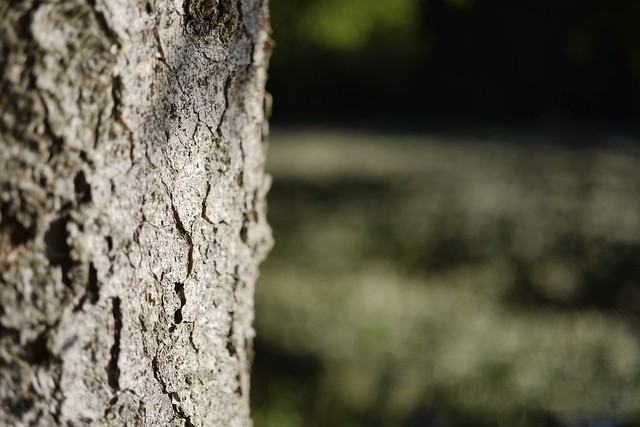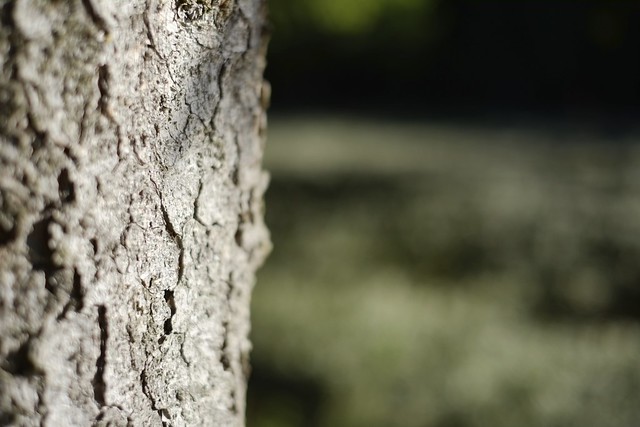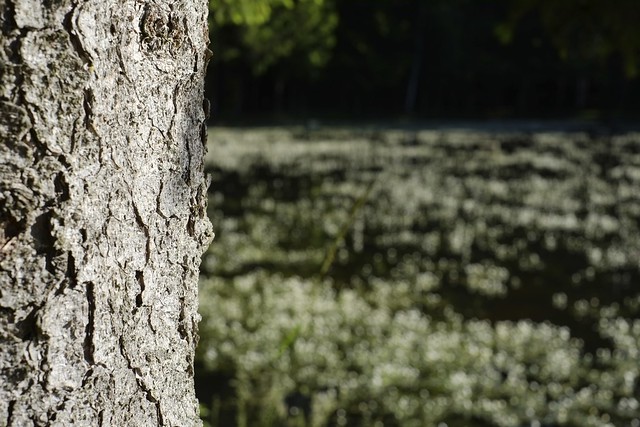Zeiss Touit vs. Fujinon XF
Talk to Rico (open forum for questions & feedback) – Rico’s Flickr sets – Touit 1.8/32 samples – Touit 2.8/12 samples – Touit vs. Fujinon comparative samples (Flickr Guest Pass) – Mastering the Fujifilm X-Pro1 reading samples (65 free pages)
 Carl Zeiss Touit 1.8/32, Fujifilm X-E1 (ISO 200, f/2, 1/1200s), RAW, Lightroom 5, DxO FilmPack 4
Carl Zeiss Touit 1.8/32, Fujifilm X-E1 (ISO 200, f/2, 1/1200s), RAW, Lightroom 5, DxO FilmPack 4
Why would a business-savvy lens manufacturer like Carl Zeiss decide to introduce two prime lenses for X-Mount cameras that compete head-to-head with already existing, smaller and cheaper Fujinon offerings, while at the same time ignoring obvious gaps like a fast 23mm lens?
It’s a Sony
The answer is: they wouldn’t. And they didn’t! The new Zeiss Tout 1.8/32mm and 2.8/12mm prime lenses are quite obviously targeted at customers of Sony’s NEX camera system. They perfectly fit into Sony’s current lens lineup, and their design is pretty much in line with the sleek NEX appearance. A fast 23 mm lens to satisfy the cravings of the X-Mount crowd? No such luck, because Zeiss and Sony already offer such a lens (a 1.8/24) for NEX. This is apparently all about what Sony NEX customers want and need.
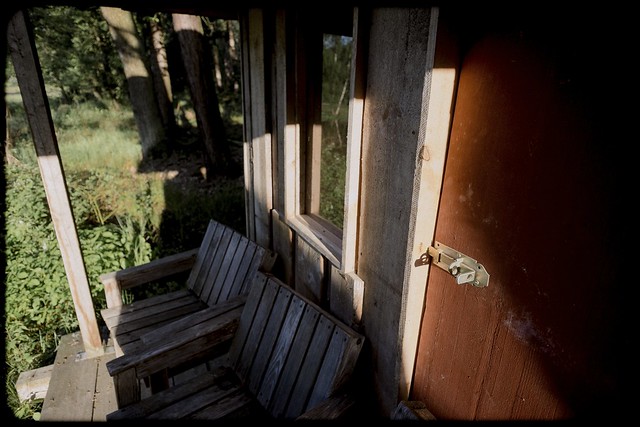 Carl Zeiss Touit 2.8/12, Fujifilm X-E1 (ISO 200, f/2.8, 1/480s), RAW, Lightroom 4.4
Carl Zeiss Touit 2.8/12, Fujifilm X-E1 (ISO 200, f/2.8, 1/480s), RAW, Lightroom 4.4
So the X-Mount versions of the Touit lenses were clearly one of those “me too” decisions. But why did Fuji go along with it and invite a formidable competitor like Carl Zeiss into their home, not only offering full technical support and cooperation, but even co-marketing the Touit lenses? I know the real answer but don’t want to spill the beans just yet, so let’s just say that Fujifilm is making money with each X-Mount Touit lens that’s sold. They also like the Zeiss brand’s premium image and the resulting image transfer to the Fuji brand. After all, Panasonic also loves to put a Leica logo on their cameras and MFT lenses.
That said, the Zeiss “me too” attitude also brings about some issues. While form usually follows function, it’s a bit of the opposite with the two X-Mount versions of the Touit lenses. Let’s compare both versions:

It’s hard to overlook the ergonomic differences: NEX lenses don’t need aperture rings, so there’s plenty of room for a broad manual focus ring. To contribute to the sleek overall design, the ring is smoothly rubber-coated and doesn’t stick out from the casing of the lens. That’s great for NEX users, but not so great for X-Mount users, as “our” versions of the lenses have two much more narrow function rings: one for manual focus and one to select the aperture. They are also hard to “feel and find”, as they don’t stick out, and the rubber surface is as smooth as the surrounding casing:
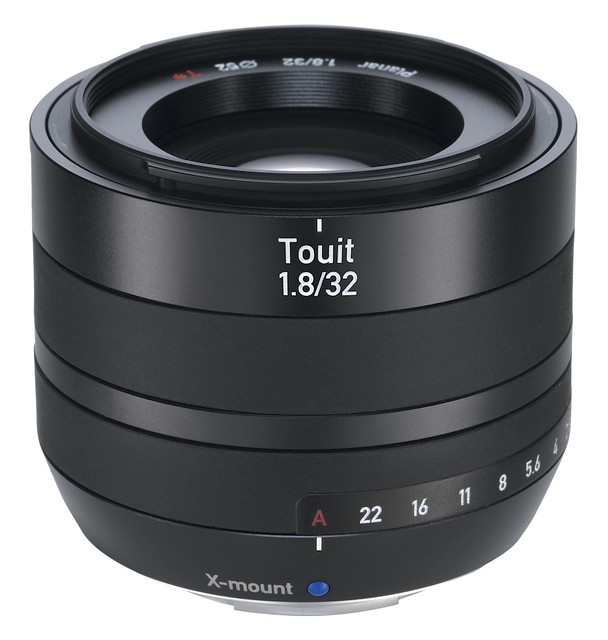
Here’s the XF35mmF1.4 R with its traditional, ripped aperture and focus rings:
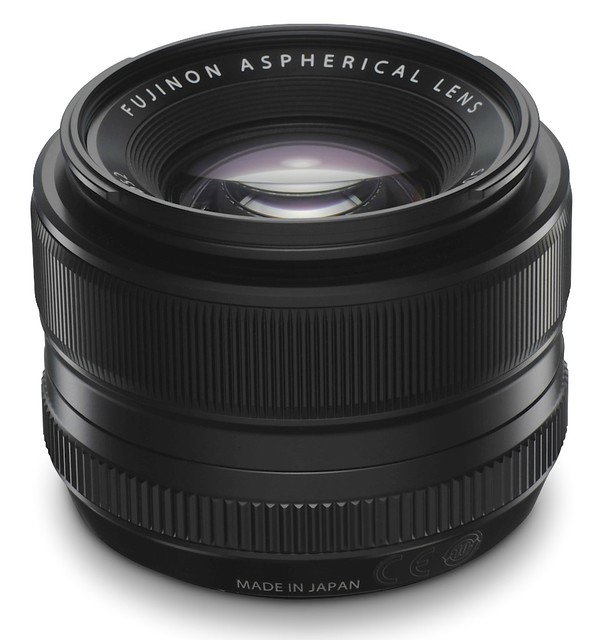
It’s pretty much the same situation with the Touit 2.8/12 and the XF14mmF2.8 R lenses:
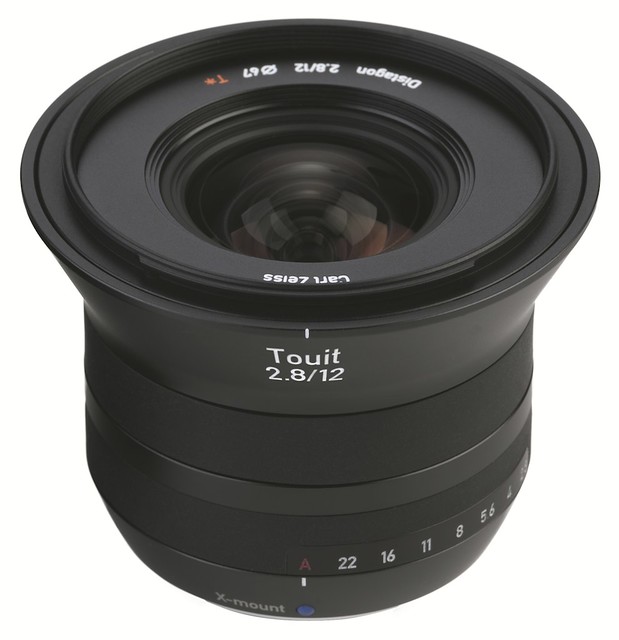
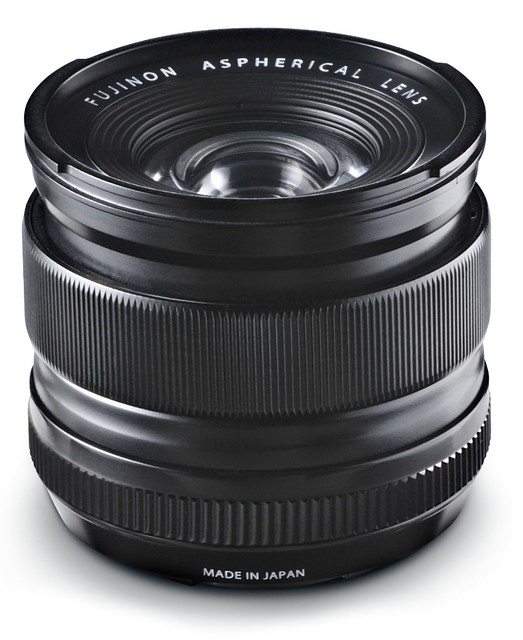
So before we discuss build quality, features and IQ, you should be aware of the conceptual differences between Zeiss Touit and Fujinon XF lenses: With the Touits, you get a “designed for NEX” product that happens to also be available in an adapted X-Mount version.
 Carl Zeiss Touit 1.8/32, X-E1 (ISO 200, f/1.8, 1/900s), SOOC JPEG (Astia)
Carl Zeiss Touit 1.8/32, X-E1 (ISO 200, f/1.8, 1/900s), SOOC JPEG (Astia)
Specifications, Weight and Size
Let’s have a quick look at the specs of the new lenses–and their legacy counterparts from Fujinon:
Touit 1.8/32 – XF35mmF1.4 R
Touit 2.8/12 – XF14mmF2.8 R
The focus range of both wide-angle lenses starts at 18 cm, and the minimum focus distance of the “standard” 35 mm / 32 mm lenses is 28 cm (Fujinon) and 30 cm (Zeiss), respectively. However, the Zeiss lenses are both bulkier and heavier, especially if you attach the included lens hoods. Here are a few pics I took during my testing that help illustrate those differences:
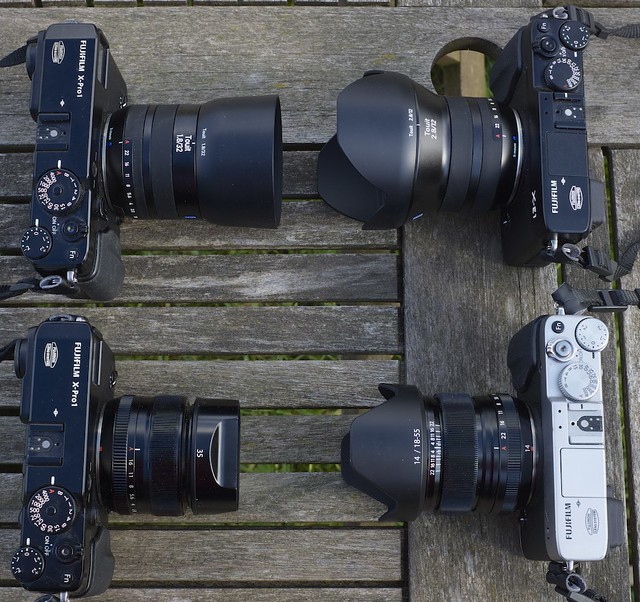
35 mm / 32 mm:
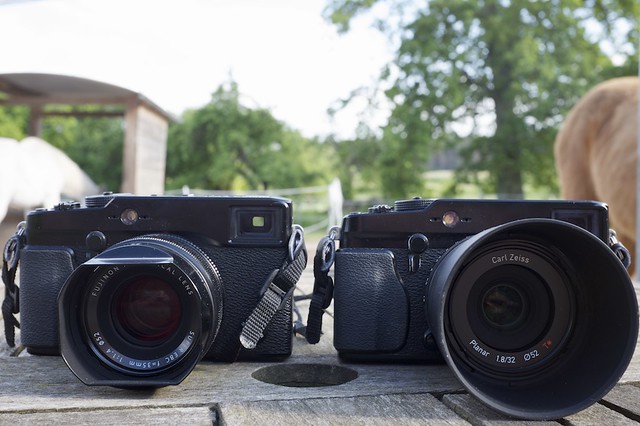
14 mm / 12 mm:
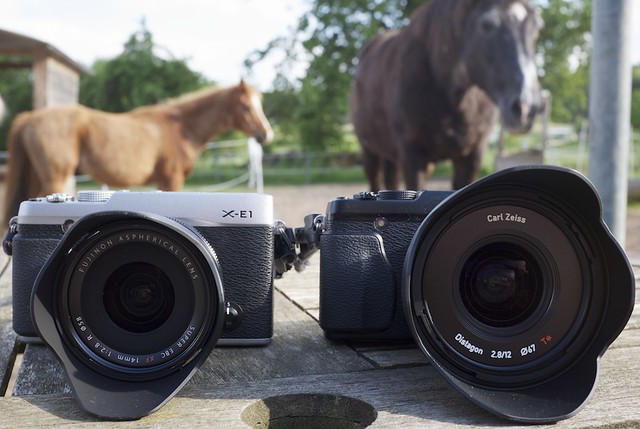
It becomes obvious that the Zeiss Touit lenses are bulkier than their Fujinon counterparts. X-Pro1 users might also worry about how usable the Touits are in concert with the OVF (optical viewfinder) of their camera, as the lenses (and lens hoods) were apparently designed for cameras with EVFs (electronic viewfinders), where size matters less, because the lens barrel and hood cannot obstruct the user’s field of view when he’s framing a shot.
Build Quality
Like their siblings from Fujinon, the Zeiss Touit lenses are made in Japan and solidly built, though the rubber-coated aperture and focus rings of the Touits are sensitive to sharp and pointy objects. You can leave a permanent mark by simply by pressing your fingernails into the rubber. As I already mentioned, the ergonomics of the aperture and focus rings are somewhat questionable due to the choice of materials and design—at least for users who shoot in aperture priority mode and like to change their aperture setting quickly and frequently.
The aperture ring of the 2.8/12 is considerably “looser” than the ring of the 1.8/32, and I couldn’t make out any differences in resistance between full and intermediate (1/3 EV) clicks. That said, neither lens looks, feels or handles “cheaply”, and there’s a nice blue Zeiss logo on both sides of each Touit lens that you can use to brag and show off if you feel like it. ;) I mean, that’s why most people buy their Leicas, isn’t it?
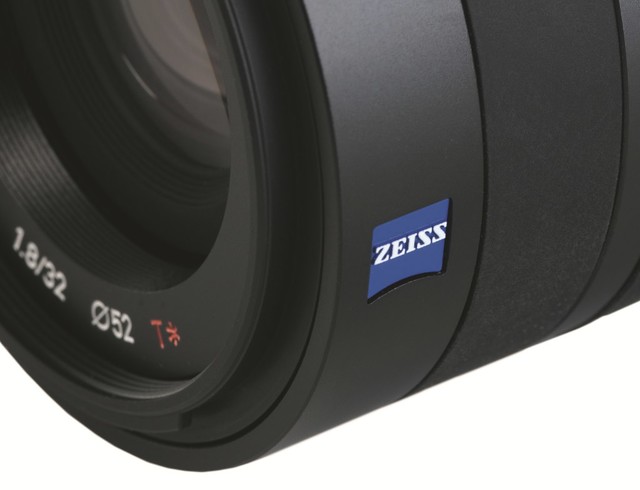
OVF Compatibility
X-Pro1 users will be glad to hear that both Touit lenses can be used in concert with the X-Pro1’s optical viewfinder (OVF), though there are certain limitations. At 99° (diagonal) / 89° (horizontal) / 66° (vertical), the field of view (FOV) of the 2.8/12 is too large for the OVF (which barely fits the Fujinon XF 14mmF2.8 R), so you will only see a portion of what’s actually recorded. However, the camera does automatically recognize the focal length and will display parallax-corrected AF frames.
Of course, the 1.8/32 also works with the X-Pro1. However, the OVF always initializes in its wide-angle position (which is optimized for Fuji’s 18 mm prime), so you have to press and hold the viewfinder selector lever for a few seconds to manually switch the OVF to its higher magnification level, which is optimized for focal lengths of 35 mm and higher. But no worries, the magnified OVF then works just fine with the 32 mm focal length of the Zeiss Touit lens.
Due to their size, both Touits block a larger portion of the OVF’s field of view than their Fujinon counterparts. However, I found the Touit 1.8/32 still quite usable when looking through the optical viewfinder, even when its lens hood was attached. Due to its FOV limitations, the Touit 2.8/12 is best used with an EVF, anyway.
 Carl Zeiss Touit 1.8/32, Fujifilm X-E1 (ISO 200, f/2, 1/1400s), SOOC JPEG, Alien Skin Exposure 5
Carl Zeiss Touit 1.8/32, Fujifilm X-E1 (ISO 200, f/2, 1/1400s), SOOC JPEG, Alien Skin Exposure 5
Firmware, Features and AF
The Touit X-Mount versions do not offer any special features. Both lenses are of the acquainted focus-by-wire type and offer no optical image stabilization. Unlike Fuji’s 14 mm prime, the Touit 2.8/12 has no switchable focus ring and no engraved DOF scale. There’s some good news in this, though: Neither the X-E1 nor the X-Pro1 require firmware upgrades to fully support the X-Mount Touit lenses.
The Touit lenses house conventional AF motor drives, not the fast and silent linear motors that were built into Fujinon’s current XF zooms. The AF speed performance of the Touit 2.8/12 lags a little bit behind the XF14mmF2.8 R lens, while the AF performance of the Touit 1.8/32 and XF35mmF1.4 R appear to be on par.
Now what?
Comparing the respective Fujinon and Zeiss offerings based on price, features, speed, weight, size and ergonomics, it’s hard to imagine anyone choosing the 1.8/32 mm over the less expensive, lighter, smaller and more ergonomic XF35mmF1.4 R—or the 2.8/12 over the XF14mmF2.8 R with its innovative manual focus ring and analog DOF scale.
Of course, we all know that this ain’t the entire story. For starters, there is an actual difference between the field of view of a 12 mm and a 14 mm lens. In full-frame terms, it’s the same difference as between an 18 mm and a 21 mm lens.
So if you happen to love 12 mm, but wouldn’t know what to do with 14 mm, the Touit will be the right lens for you. As for 32 mm vs. 35 mm, there’s a slight FOV difference, as well:
Choosing either the Zeiss or the Fujinon option eventually boils down to image quality. In order to be worth the higher price (and to justify the extra weight and size), the Touits should be optically superior. If they are not, all you get for your extra money is that blue Zeiss label to brag about. ;)
At Close Range
If I had to identify one area where the Touit 1.8/32 is clearly superior to the XF35mmF1.4 R, it would be close range and macro shots at open aperture. For the following illustration, I manually focussed both lenses to their respective minimal focal distance, set the aperture to f/1.8 and closed in on the center of my cancerogenous subject until the 10x magnifier tool of the X-E1 showed it in perfect focus.
Here’s the Touit 1.8/32 at f/1.8:

And here’s the XF35mmF1.4 R, also at f/1.8:

Click on the images to access my comparative set of images with a Flickr Guest Pass.
At close distances and open aperture, the Zeiss Touit is clearly sharper than the Fujinon, in the center and even more so near the edges.
Here’s how it looks like stopped down to f/5.6:
As is to be expected, stopping down the lenses levels the playing field. As far as bokeh is concerned, most people seem to prefer the Fuji rendering.
Here’s another example to illustrate sharpness and bokeh at two different aperture settings.
Since bokeh is mostly a matter of personal preference, I’m not going to comment much on it. See for yourselves and make up your own minds.
With increasing focus distance, both Fujinons render the scenes at least at sharp as their Zeiss counterparts. When you are pixel peeping through the sample sets, there’s an interesting observation to me made: While the Fujinons are at their best and sharpest at typical “sweet spot” apertures between 5,6 and 8, both Touits perform best with only slightly stopped down apertures.
Speaking of apertures, the blur circles in the following sample images help illustrate the shape of the Touits’ aperture diaphragm:
Touit 1.8/32 (f/8, SOOC JPEG):
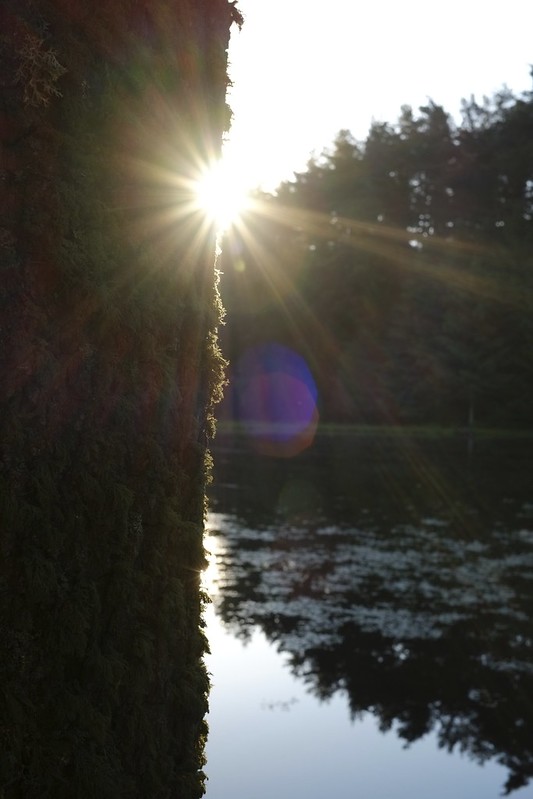
Touit 2.8/12 (f/8, SOOC JPEG):
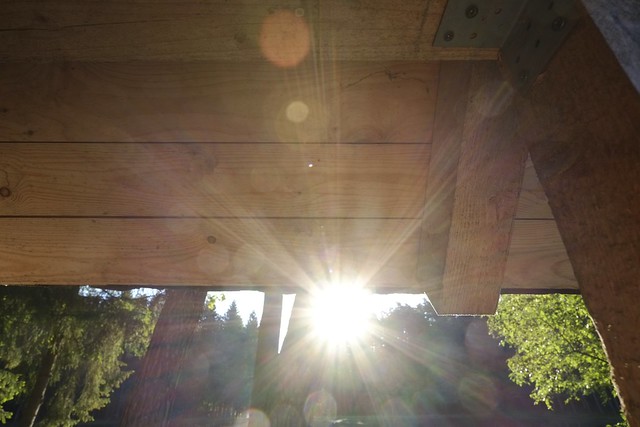
Here are two SOOC portrait samples, shot with identical exposure settings at f/2. One was photographed with the Touit 1.8/32, one with the XF35mm1.4 R. Can you immediately tell which one is which…?
Distortion Correction
Neither the XF35mmF1.4 R nor the XF14mmF2.8 R apply any digital distortion correction, as these lenses are optically corrected. With the Touits, it’s a different story: Both the 2.8/12 and the 1.8/32 rely on digital correction and embed the lens correction profiles in the metadata of the RAW files. Compatible RAW converters (such Adobe Lightroom/ACR, Apple Camera RAW, Silkypix/RAW File Converter EX or Capture One) can read and interpret these embedded profiles and automatically apply the appropriate digital corrections to the image.
 Carl Zeiss Touit 2.8/12, Fujifilm X-E1 (ISO 200, f/8, 1/250s), RAW / Capture One Pro, no distortion correction.
Carl Zeiss Touit 2.8/12, Fujifilm X-E1 (ISO 200, f/8, 1/250s), RAW / Capture One Pro, no distortion correction.
In order to study the scope of such corrections, it’s best to load the RAW files into Capture One and process the image twice: once with 100% and once with 0% of applied distortion correction. Here’s an example:
Touit 2.8/12 without digital distortion correction:

Touit 2.8/12 with digital distortion correction:

As you can see, a portion of the image area is cut off because of the correction. Since digital correction is digitally stretching and interpolating parts of the image near corners and edges, it always results in a (slight) loss of image quality. Here’s another example, taken with the Touit 1.8/32 lens…
Touit 1.8/32 without digital distortion correction:

Touit 1.8/32 with digital distortion correction:

The latest versions of Adobe Lightroom and ACR include dedicated lens profiles for both Touit lenses, but those were made for users of the NEX versions. Don’t apply them to your Fuji shots, or you will over-correct an already corrected image.
Touit? Or don’t Touit?
That is the question, isn’t it? And the answer is a tricky one! At least one thing is clear: If you already own an XF35mmF1.4 R or XF14mmF2.8, there’s no need to spend serious money on making the switch to Zeiss. If you Touit, you won’t get lenses that are categorically better—just different.
What are those differences? Apart from price, bulk, design and ergonomics, there’s also a difference in the optical characteristics: While the Zeiss lenses are at their best and sharpest at low aperture numbers, the Fujinons are more conventional and will deliver optimal results at moderate apertures like 5.6 or 8. And while the Touit 1.8/32 shines at close range even when shot wide open, the XF35mmF1.4 delivers stunning overall detail at moderate ranges to infinity. Of course, you’ll only have a chance of actually recognizing these subtle differences when you look at test shots taken with a tripod at 100% magnification. For “normal” shooting (especially at higher ISOs), this discussion is largely irrelevant, and when the push comes to shove, the faster XF35mmF1.4 R may give you just that extra speed you need to crisply nail a shot instead of motion blurring it. Real life and lab shots often don’t mix well.
Also, don’t forget colors, contrast and bokeh. Touits and Fujinons are somewhat different in that regard, as well. Most people I have spoken to seem to like the softer bokeh of the XF35mmF.14 R better than the more punchy one of the Touit 1.8/32. However, these are questions of personal taste and what specific application the lens is supposed to perform. It’s not about “good” or “bad”, it’s rather about qualities that make up the identity and character of a specific lens.
On the other hand, some of those character differences are less pronounced than one might think. Looking at the (cropped) SOOC JPEG shots below (taken at f/10, 1/100s), can you immediately tell which one was taken with a Touit and a Fujinon?
Make up your own mind! I have established full-size image sample sets on Flickr for both lenses. Here’s a link to the 1.8/32 set, and here’s one to the 2.8/12 set. I have also created a set with comparative image samples (including the Fujinons) that you can inspect with a Flickr Guest Pass. Just click here to get there right away.
This little column cost me more than 30 unpaid hours to create, so I appreciate your consideration of my book (see links below). It’s the only reimbursement I can possibly get, as I am not receiving any kind of participation from ads, ref-links or whatnot on this site.
And to all the EXR fans waiting for my “article of articles” that unveils the inner working of Fujifilm’s EXR sensor: I haven’t forgotten about you.
By the way, did you catch the news about the organic image sensor Fujifilm and Panasonic are bringing to market? If not, here’s a link to the official press release. I expect actual digital cameras to feature this sensor design within 18-24 months from now.
For your convenience, here’s a TOC with links to my previous X-PERT CORNER articles:
- Remote Shutter Control for X Series Cameras
- Apple Camera RAW, X-Trans and EXR
- First Look: XF55-200mmF3.5-4.8 R LM OIS
- Studio X
- Using the X100S
- Using the X20
- X100S vs. X100
- X20 vs. X10
- RAW, JPEG, Silkypix and “Fuji Colors”
- Adapting Third-Party Lenses (updated with Speed Booster)
- RAW for JPEG Shooters…
- Tips for Updating your Firmware
- How to Clean the X-Trans Sensor
- Using the XF14mmF2.8 R
- Decoding XF18-55mmF2.8-4 R LM OIS
- Comparing RAW converters: JPEG vs. Lightroom, Capture One, Silkypix & RPP
- XF14mmF2.8 R appears to be almost distortion free
- How to Expand Dynamic Range
- How to Use Extended ISO
- EXR, anyone?
- Capture One – When the Going Gets Tough…
- Using Shooting Profiles and the Quick Menu
Rico Pfirstinger studied communications and has been working as journalist, publicist, and photographer since the mid-80s. He has written a number of books on topics as diverse as Adobe PageMaker and sled dogs, and produced a beautiful book of photographs titled Huskies in Action (German version). He has spent time working as the head of a department with the German Burda-Publishing Company and served as chief editor for a winter sports website. After eight years as a freelance film critic and entertainment writer in Los Angeles, Rico now lives in Germany and devotes his time to digital photography and compact camera systems. His book “Mastering the FUJIFILM X-Pro1” (Kindle Edition) (Apple iBook Store) (German version) is available on Amazon and offers a plethora of tips, secrets and background information on successfully using Fuji’s X-Pro1 and X-E1 system cameras, lenses and key accessories.








